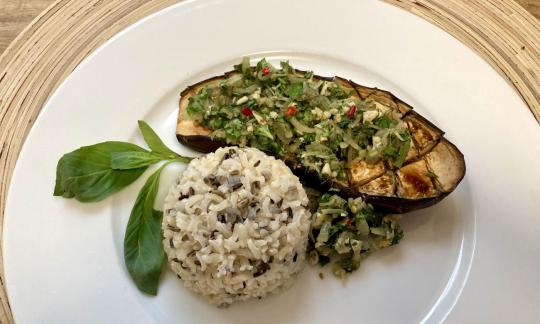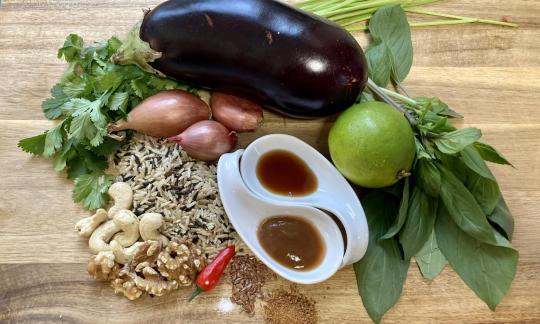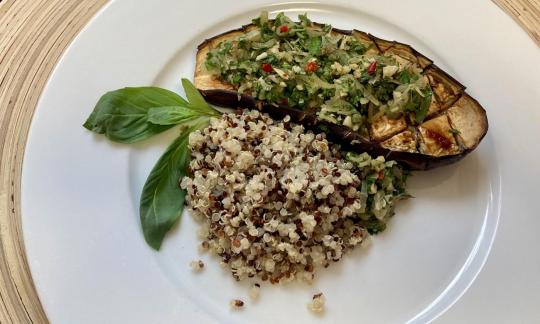Baked Asian Eggplant with Horapa on Brown Rice
vegan
Ingredients (for servings, )
| For the basis | |
|---|---|
| 4 ½ oz | Whole grain rice, brown rice (raw, organic?) |
| 375 ml | Drinking water, raw (organic?) (13 oz) |
| 2 | Eggplant, raw (organic?) (24 oz) |
| For the topping | |
| 7 ⅓ oz | Shallots, raw (organic?) |
| ⅔ oz | Walnuts (tree nuts), raw (organic?) |
| ⅔ oz | Cashew nuts, raw? organic? (cashew nuts) |
| 1 tsp, ground | Linseed, raw, organic? (golden linseed, flax) (0.09 oz) |
| ½ oz | Coriander leaves, raw |
| 1 oz | Horapa, raw (Thai basil, organic?) |
| 1 | Chili peppers, red, raw (organic?) (0.18 oz) |
| 1 dash | Table salt (table salt, raw?, organic?) (0.01 oz) |
| 1 tbsp | Lime juice (raw?, organic?) (0.25 oz) |
| For the dressing | |
| 2 tbsp | Reduced salt soy sauce (Genen-Shoyu, organic?, raw?) (1.1 oz) |
| 1 tbsp | Coconut blossom sugar (palm sugar, coconut sugar, raw?, organic?) (0.31 oz) |
| ⅔ tbsp | Tamarind paste (raw?, organic?) (0.28 oz) |
| 1 | Chili peppers, red, raw (organic?) (0.18 oz) |
| 2 tbsp | Lime juice (raw?, organic?) (0.51 oz) |
Equipment
- skillet (frying pan)
- stove
- coffee grinder, electric
- citrus juicer (lemon squeezer)
- saucepan
- oven
- baking sheet (cookie sheet)
Type of preparation
- cook
- bake
- chop or grind
- squeeze
- sweat
- remove the skin
Preparation
For the eggplants
Preheat the oven to 180 °C. Wash the aubergines and cut them in half lengthways. Make a cross-shaped cut into the cut surfaces, moisten with a little water and spread out on a baking tray lined with baking paper with the cut surface facing upwards.Optionally, you can brush the eggplants with refined rapeseed oil.
Bake at 180 °C for about 30 - 40 minutes until the eggplants are nice and soft. After about half the time, moisten the eggplants again (reduce the temperature a little if necessary) and finish baking.
Continue with the next steps while the cake is baking.
For the rice
Put the rice in a pan with three times the amount of water and bring to the boil. Cook at a low temperature for about 20 - 25 minutes. At the end of the cooking time, pour off any remaining water, keep the rice warm and set aside.Continue with the next steps while cooking.
Other side dishes: Instead of brown rice (here wholegrain long grain rice mixed with wild rice), you can also use quinoa or sticky rice as a side dish. The latter can be easily found in online shops or Asian supermarkets.
For the topping
Peel the shallots, halve them and cut them into thin rings. Then put them in a pan with a little water and sauté at a medium temperature for about 5 - 10 minutes until they are cooked. Stir occasionally and add a little water if necessary. Meanwhile, chop the walnuts and cashews and put them in a bowl.Optionally, you can also sauté the shallots with some refined rapeseed oil.
Onions: If you don't have enough shallots on hand, you can replace some, but no more than half, with onions.
Chop the chili and add to the nuts. Wash the coriander and horapa, shake dry and pick off the leaves. Finely chop the herbs and add to the nuts. Grind the flaxseed and add to the bowl with 1 tablespoon of lime juice.
For a quantity of 2 portions, we used ½ large bunch of coriander (approx. 15 g leaves without stems) and 2 bunches of horapa (approx. 30 g including stems).
For the dressing
Put the palm sugar, soy sauce and tamarind paste with the finely chopped chili in a pan with a few tablespoons of water and heat until the sugar dissolves. Remove from the heat and add the lime juice.You can also leave out the sugar altogether at this point. In that case, however, use a little less lime juice.
Completing the recipe
Arrange the baked eggplants on a plate and drizzle with some dressing. Spread the topping on top and serve with rice as a side dish.
|
Nutritional Information per person
Convert per 100g
|
2000 kcal | |
|---|---|---|
| Energy | 558 kcal | 27.9% |
| Fat/Lipids | 14 g | 20.1% |
| Saturated Fats | 1.9 g | 9.7% |
| Carbohydrates (inc.dietary fiber) | 98 g | 36.2% |
| Sugars | 27 g | 29.6% |
| Fiber | 18 g | 73.1% |
| Protein/Albumin | 16 g | 32.3% |
| Cooking Salt (Na:628.2 mg) | 1'596 mg | 66.5% |
| Essential micronutrients with the highest proportions | per person | 2000 kcal | |
|---|---|---|---|
| Min | Copper, Cu | 59 mg | 5'871.0% |
| Min | Manganese, Mn | 4.4 mg | 219.0% |
| Vit | Vitamin K | 103 µg | 137.0% |
| Vit | Vitamin B6 (pyridoxine) | 1.3 mg | 90.0% |
| Elem | Potassium, K | 1'580 mg | 79.0% |
| Sodium, Na | 628 mg | 79.0% | |
| Vit | Folate, as the active form of folic acid (née vitamin B9 and | 150 µg | 75.0% |
| Prot | Tryptophan (Trp, W) | 0.17 g | 68.0% |
| Elem | Phosphorus, P | 462 mg | 66.0% |
| Fat | Alpha-Linolenic acid; ALA; 18:3 omega-3 | 1.3 g | 64.0% |
Detailed Nutritional Information per Person for this Recipe
The majority of the nutritional information comes from the USDA (US Department of Agriculture). This means that the information for natural products is often incomplete or only given within broader categories, whereas in most cases products made from these have more complete information displayed.
If we take flaxseed, for example, the important essential amino acid ALA (omega-3) is only included in an overarching category whereas for flaxseed oil ALA is listed specifically. In time, we will be able to change this, but it will require a lot of work. An “i” appears behind ingredients that have been adjusted and an explanation appears when you hover over this symbol.
For Erb Muesli, the original calculations resulted in 48 % of the daily requirement of ALA — but with the correction, we see that the muesli actually covers >100 % of the necessary recommendation for the omega-3 fatty acid ALA. Our goal is to eventually be able to compare the nutritional value of our recipes with those that are used in conventional western lifestyles.
| Essential fatty acids | per person | 2000 kcal |
|---|---|---|
| Alpha-Linolenic acid; ALA; 18:3 omega-3 | 1.3 g | 64.0% |
| Linoleic acid; LA; 18:2 omega-6 | 5.5 g | 55.0% |
| Essential amino acids | per person | 2000 kcal |
|---|---|---|
| Tryptophan (Trp, W) | 0.17 g | 68.0% |
| Threonine (Thr, T) | 0.53 g | 57.0% |
| Isoleucine (Ile, I) | 0.61 g | 49.0% |
| Valine (Val, V) | 0.76 g | 47.0% |
| Leucine (Leu, L) | 1.0 g | 43.0% |
| Phenylalanine (Phe, F) | 0.65 g | 42.0% |
| Lysine (Lys, K) | 0.61 g | 33.0% |
| Methionine (Met, M) | 0.24 g | 25.0% |
| Vitamins | per person | 2000 kcal |
|---|---|---|
| Vitamin K | 103 µg | 137.0% |
| Vitamin B6 (pyridoxine) | 1.3 mg | 90.0% |
| Folate, as the active form of folic acid (née vitamin B9 and | 150 µg | 75.0% |
| Thiamine (vitamin B1) | 0.59 mg | 54.0% |
| Niacin (née vitamin B3) | 7.0 mg | 44.0% |
| Pantothenic acid (vitamin B5) | 2.5 mg | 42.0% |
| Vitamin C (ascorbic acid) | 31 mg | 39.0% |
| Riboflavin (vitamin B2) | 0.25 mg | 18.0% |
| Vitamin E, as a-TEs | 2.0 mg | 16.0% |
| Biotin (ex vitamin B7, H) | 5.2 µg | 10.0% |
| Vitamin A, as RAE | 71 µg | 9.0% |
| Essential macroelements (macronutrients) | per person | 2000 kcal |
|---|---|---|
| Potassium, K | 1'580 mg | 79.0% |
| Sodium, Na | 628 mg | 79.0% |
| Phosphorus, P | 462 mg | 66.0% |
| Magnesium, Mg | 207 mg | 55.0% |
| Calcium, Ca | 142 mg | 18.0% |
| Essential trace elements (micronutrients) | per person | 2000 kcal |
|---|---|---|
| Copper, Cu | 59 mg | 5'871.0% |
| Manganese, Mn | 4.4 mg | 219.0% |
| Iron, Fe | 5.1 mg | 37.0% |
| Zinc, Zn | 3.5 mg | 35.0% |
| Selenium, Se | 19 µg | 35.0% |
| Fluorine, F | 134 µg | 4.0% |
| Iod, I (Jod, J) | 0.86 µg | 1.0% |
Baked Asian eggplant with horapa and coriander on brown and wild rice - can also be combined with other side dishes.
Portion size: The specified amount of 2 portions corresponds to a main course for 2 people if you use 2 smaller aubergines. If you use large aubergines, it is suitable for more people, depending on the amount of side dish.
Nutrient profile: According to GDA guidelines, one portion of this high-fiber dish provides well over 100% of the essential trace element manganese and 100% of the copper. Vitamin B6 and folic acid are covered between 70 and 90% and omega-3 fatty acids are covered by 65%. However, some of the heat-sensitive ingredients such as folic acid are lost during the cooking process, which slightly reduces the amount per portion. The ratio of omega-6 to omega-3 fatty acids is 4:1, which is below the maximum recommended ratio of 5:1.
You can find further information on this topic at the following link: Vegans often eat unhealthily. Avoidable nutritional errors.
Eggplants: There are several types that differ in shape and color. The most common varieties sold in Europe and North America are elongated and have a dark purple color. The raw fruit has a slightly bitter taste with a somewhat astringent quality.
Brown rice: Wholegrain rice or brown rice retains its natural silver skin after harvesting. This means that wholegrain rice is more nutritious than regular rice: the vitamins and minerals remain on the grain. Wholegrain rice has a slightly nutty taste, keeps you full for a long time and contains valuable vitamins and minerals.
Horapa, Thai basil: Horapa is a variety of the European basil plant. Unlike the European basil plant, however, the stem and flowers are purple and the leaves are lanceolate. The aroma is also very different from "ordinary" basil, as Horapa has a distinctly aniseed and licorice-like scent and taste paired with a slight spiciness.
Coriander: Coriander leaves, sometimes also known as Chinese parsley, have a refreshing, lime-like taste for some people. Others, however, have a strong aversion to its taste and smell. Studies have shown that such aversion can be traced back to genetic differences. Coriander leaves spoil quickly and should therefore be used as fresh as possible.
Tamarind paste: A distinction is made between sweet and sour tamarind fruit. The former can be found in well-stocked supermarkets. Tamarind paste is the concentrated pulp of the sour tamarind fruit. It can be found in Asian shops.
Reduce salt and oil: We have deliberately avoided using oil and used low-salt soy sauce (Genen Shoyu) to keep the salt content as low as possible without compromising on taste. Since salt requirements vary depending on individual habits, it is best for you to decide for yourself. A good read on this topic is the book " Salt. Sugar, Fat ".
Nuts, seeds and fatty acids: The fat content of linseed has around 50% of the polyunsaturated omega-3 fatty acid alpha-linolenic acid (ALA), the highest concentration of omega-3 fatty acids of all known seeds. Those who eat a lot of industrial food should increase the amount of linseed in their diet and correct any nutritional errors in this regard. Of all the nuts, walnuts have the highest proportion of linolenic acid (an omega-3 fatty acid that is good for the heart). They also have health benefits thanks to tocopherols (forms of vitamin E) and many macro and trace elements. Cashew nuts contain relatively high amounts of essential omega-6 fatty acids (linoleic acid: 7.8 g/100 g = 78% of the daily requirement or the maximum daily amount) and very little ALA. The LA:ALA ratio is at least 48:1 and sometimes goes up to 130:1. For this reason, we have chosen a mixture of linseed, walnuts and cashews to achieve the best possible balance between taste and health value.
Side dish: Instead of brown rice (here wholegrain long grain rice mixed with wild rice), you can also use quinoa or sticky rice (also available in the wholegrain version) as a side dish. The latter can be easily found in online shops or Asian supermarkets.
Oil: If you don't want to do without oil completely, you can use oil to sauté the shallots and also coat the aubergines with oil (before baking and once halfway through the cooking time). It is best to use refined rapeseed oil for this. This has a high proportion of essential fatty acids, especially omega-3 fatty acids, and, unlike cold-pressed rapeseed oil, you can also heat it to high temperatures.
Onions: If you don't have enough shallots on hand, you can replace some, but no more than half, with onions.
Palm sugar: Palm sugar can now be found in every well-stocked supermarket and in Asian supermarkets. If you don't have any on hand, you can use either brown cane sugar or maple syrup or date sugar. In addition to being sweet, these sweeteners also have a certain malty taste, which is desirable here.








